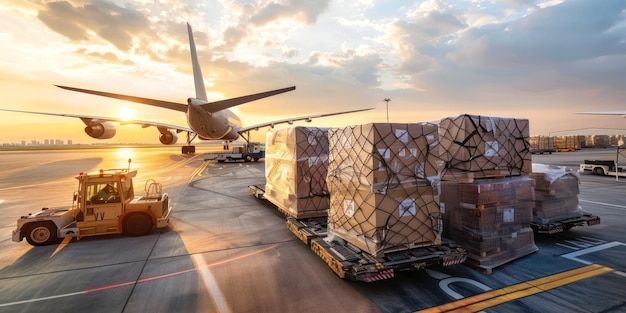Air Shipping
Air shipping also known as air freight, is the transportation of goods via aircraft from one location to another. It is one of the fastest and most efficient modes of transportation, particularly for time-sensitive shipments or goods that require rapid delivery. Here’s an overview of air shipping:

Types of Air Shipping:
General Cargo:
General cargo refers to standard shipments of goods that are not perishable or hazardous.
It includes a wide range of products, such as electronics, apparel, machinery, and consumer goods.
Express Shipping:
Express shipping services, offered by companies like FedEx, UPS, and DHL, specialize in fast delivery of small packages and documents.
These services typically provide expedited customs clearance and door-to-door delivery options.
Temperature-Controlled Shipping:
Temperature-controlled air freight is used for perishable goods, pharmaceuticals, and other temperature-sensitive products.
Specialized containers and facilities maintain specific temperature ranges to preserve the integrity of the cargo.
Heavy and Oversized Cargo:
Air freight can accommodate heavy and oversized cargo, such as machinery, equipment, and vehicles, through specialized freighter aircraft or charter services.

Air Shipping Process:
Booking:
Shippers book space on a cargo aircraft with an airline or through a freight forwarder.
Documentation:
Shippers prepare shipping documents, including air waybills, commercial invoices, packing lists, and certificates of origin.
Packing and Preparation:
Shippers package their cargo according to airline regulations and load it onto pallets or containers for air transport.
Transportation:
The cargo is transported to the airport of departure, where it undergoes security screening and is loaded onto the aircraft.
Flight:
The aircraft departs from the origin airport and flies to the destination airport, often with scheduled stops or layovers at intermediate hubs.
Customs Clearance:
Cargo undergoes customs clearance procedures at the destination airport, including inspection, documentation verification, and payment of duties and taxes.
Unloading and Delivery:
Upon arrival at the destination airport, the cargo is unloaded from the aircraft and transferred to the consignee’s facility or to a local distribution center for further delivery.

Advantages of Air Shipping:
Speed: Air shipping is the fastest mode of transportation, offering rapid delivery of goods to almost any destination worldwide.
Reliability: Airlines operate on fixed schedules with frequent flights, providing consistent service and transit times.
Global Reach: Air freight services connect major cities and remote regions across the globe, facilitating global trade and commerce.
Security: Airports and airlines implement strict security measures to protect cargo from theft, tampering, and damage during transit.
Considerations:
Cost: Air shipping is generally more expensive than sea or road transportation, particularly for bulky or heavy cargo.
Limited Capacity: Cargo aircraft have limited capacity compared to ocean vessels, which may result in space constraints during peak seasons or high-demand periods.
Regulatory Compliance: Shippers must adhere to strict regulations and requirements governing air cargo, including hazardous materials restrictions, weight limits, and packaging standards.
Overall, air shipping offers a fast and reliable solution for transporting time-sensitive goods and high-value commodities, enabling businesses to meet tight deadlines and satisfy customer demands for expedited delivery.
